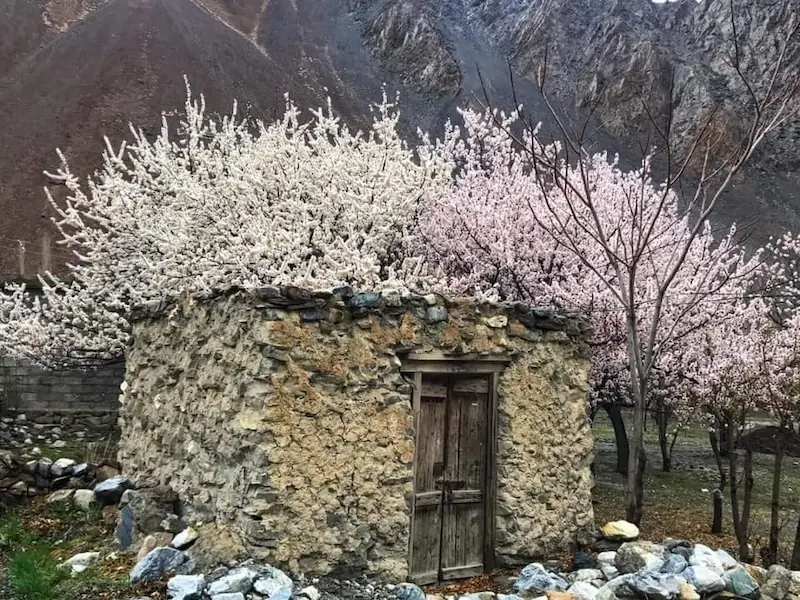Every spring, the remote valleys of Hunza in northern Pakistan transform into a dreamscape that feels like it’s been lifted straight from a fairy tale.
For just a few short weeks between mid-March and mid-April, Cherry Blossom starts in Hunza valley. Thousands of cherry, apricot, almond, apple, and walnut trees explode into delicate clouds of pink and white, set against the towering, snow-covered giants of the Karakoram, including Rakaposhi (7,788 m), Ultar Sar, and the legendary Passu Cones.
This fleeting transformation is not only a feast for the eyes but also a deeply meaningful season for the people of Hunza. Locals call it the “Blossom Season”, and it marks both the arrival of spring and the beginning of a new agricultural cycle.
Many families celebrate Navroz (March 21), the Persian New Year, during this time, a centuries-old tradition symbolizing renewal, prosperity, and harmony with nature.
During this period, photographers, nature lovers, and travelers from around the world time their visits to witness this short-lived spectacle.
This guide will take you through cherry blossom season in Hunza Valley, the best time to visit, the top cherry blossom viewing spots, local festivals, photography tips, and everything you need to plan your own unforgettable spring journey to Hunza.
You can book Hunza Cherry Blossom Tour with us.
Why Cherry Blossom in Hunza is a Must-Experience?
Each spring, Hunza Valley becomes one of the most breathtaking destinations in the world, a place where pastel-pink blossoms meet the raw power of the Karakoram mountains.
This rare combination of delicate beauty and rugged grandeur makes it a bucket-list experience for travelers, photographers, and nature lovers alike.
1. Nature’s Most Striking Contrast
In Hunza, cherry blossoms bloom under the shadow of snow-clad giants like Rakaposhi (7,788 m) and Ultar Sar. The soft blush of petals against rugged peaks and turquoise rivers creates a dreamlike contrast that few places on Earth can match.
Unlike in cities or botanical gardens, these blossoms spread across entire villages, terraced fields, and mountain slopes.
2. More Than Just Cherry Trees
Hunza’s blossom season is actually the blooming of multiple fruit trees, cherry, apricot, almond, apple, and walnut, each adding its own hue to the valley.
Apricot trees burst in creamy white, almonds in pale pink, cherries in deep blush, and apple blossoms in soft white-pink. Together, they create a layered canvas of spring colors.
3. A Short-Lived Spring Miracle
The beauty of Hunza’s cherry blossom season is fleeting, only 2–3 weeks of peak bloom. The petals appear almost overnight and, within days, begin to drift away with the wind.
This short window makes the experience even more special, as travelers must time their visit perfectly to witness the valley in full bloom.
Best Time to See Cherry Blossoms in Hunza Valley
Timing is everything when it comes to seeing Hunza Valley in full bloom because the valley spans different altitudes from Lower Hunza’s milder orchards to Upper Hunza’s cooler, higher peaks.
This means you can actually “chase the bloom” northward and extend your viewing window by almost a month.
Lower Hunza (Aliabad, Karimabad, Altit) – Mid-March to Early April
The season begins here, where altitudes hover around 2,000–2,300 meters. Villages like Karimabad and Altit are the first to be painted in pink and white, with cherries, apricots, and almonds all blooming at once.
By late March, the orchards are at their most photogenic, with petals drifting in the mild spring breeze.
Average Weather: Daytime temperatures range from 12–18°C (54–64°F), with crisp, cool nights around 5°C (41°F).
Upper Hunza (Gulmit, Passu, Hussaini) – Late March to Mid-April
As you move up the valley past Attabad Lake, the altitude climbs to 2,500–2,800 meters, delaying the bloom by about a week.
In Gulmit and Passu, blossoms often coincide with lingering snow on the mountainsides, creating an unforgettable contrast of winter and spring in a single frame.
Average Weather: Daytime highs hover between 8–15°C (46–59°F), with nights dipping close to 0°C (32°F).
The Role of Altitude & Microclimate
Altitude isn’t the only factor. South-facing slopes warm up faster and bloom earlier, while shaded or wind-exposed areas can lag behind by several days.
This creates micro-blooms even within the same village, giving photographers more chances to capture peak color.
Insider Tip: The Sweet Spot
For the highest chance of catching full bloom, plan your trip for the last 10 days of March. You’ll likely see Lower Hunza at its peak while Upper Hunza is just beginning to open up, giving you both lush blossoms and snow-dusted landscapes in one trip.
Top 12 Places to See Cherry Blossoms in Hunza
Cherry blossom season in Hunza isn’t just about pink petals, it’s about where you see them. From ancient forts to glacier valleys, here are the 12 most stunning locations to witness and photograph the bloom, complete with insider tips.
1. Karimabad
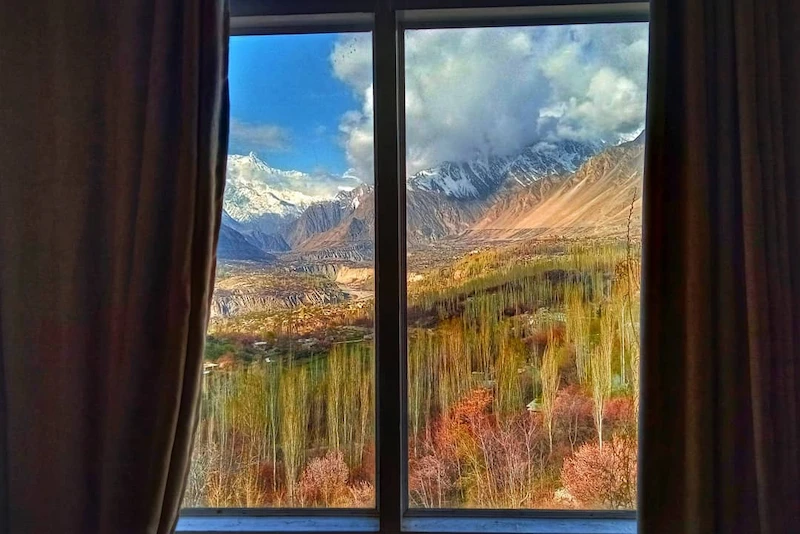
Why Visit: The heart of Lower Hunza, Karimabad is lined with cherry and apricot trees that frame postcard-perfect views of Rakaposhi and Ultar Sar. The streets themselves are a blossom tunnel in March.
Best For: Evening walks when golden light filters through the petals, or pairing your blossom shots with local markets selling handicrafts and dried fruits.
Access: Easily reached via the Karakoram Highway (KKH) — all main hotels are within walking distance.
2. Baltit Fort

Why Visit: This 700-year-old fort sits high above Karimabad, offering elevated views of the entire valley in bloom.
Photography Tip: Arrive in the morning for soft, even light and fewer crowds. From the fort’s balconies, you can capture blossoms in the foreground with Rakaposhi in the distance.
Access: A 15–20 minute uphill walk from Karimabad bazaar.
3. Altit Fort & Royal Garden (Kha Basi)
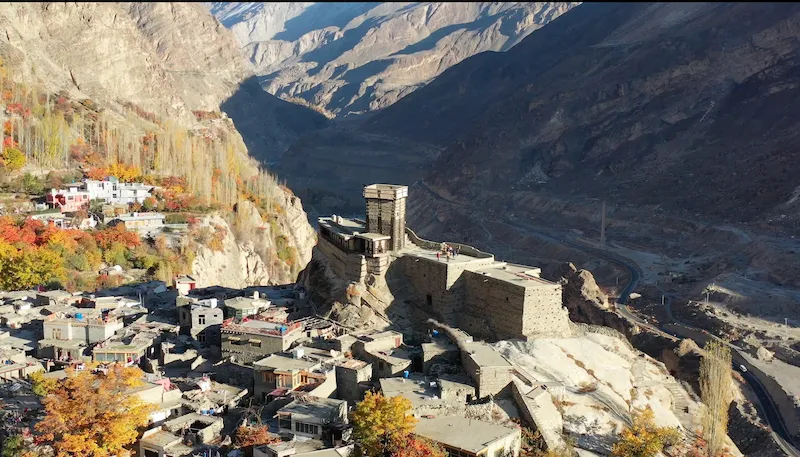
Why Visit: A perfect blend of heritage and horticulture. The Royal Garden explodes with cherry, apricot, and almond blooms.
Unique Experience: Have coffee or traditional Hunza tea at the Royal Garden Café, with petals falling around you.
Access: Short drive from Karimabad; road accessible.
4. Duiker / Eagle’s Nest

Why Visit: Known for the best panoramic view of Hunza Valley, Duiker lets you see miles of blossoms at once.
Best Time: Sunrise for golden light on snow peaks, or sunset when the valley glows pink and gold.
Access: 30-minute uphill drive from Karimabad.
5. Attabad Lake

Why Visit: This turquoise lake, created after a 2010 landslide, becomes even more surreal with pink blossoms dotting the nearby hills.
Photography Tip: Take a boat ride to capture contrasting colors of water, flowers, and mountains.
Access: About 45 minutes from Karimabad on the KKH.
6. Passu Village & Passu Cones
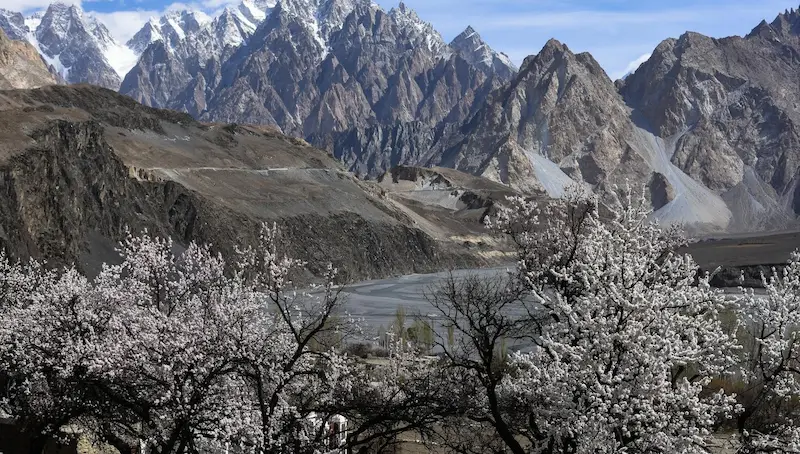
Why Visit: The dramatic, spiky Passu Cones stand behind delicate cherry blossoms — a photographer’s dream.
Experience: Take short hikes around the village for untouched blossom clusters with minimal crowds.
Access: Around 1 hour from Karimabad, north along the KKH.
7. Gulmit, Gojal
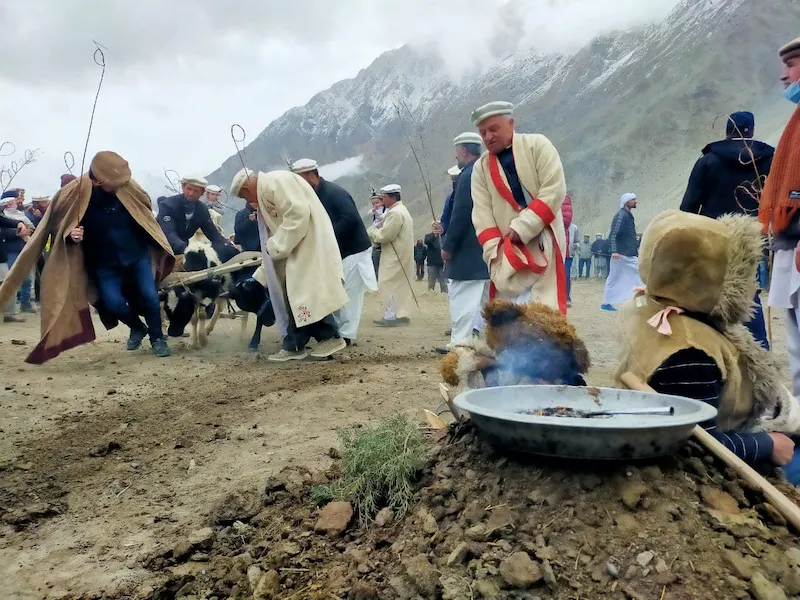
Why Visit: Known for blossom-lined alleyways and traditional stone houses, Gulmit is rich in both scenery and culture.
Bonus: Shop for local handicrafts like handwoven carpets and caps while enjoying the blooms.
Access: Just past Attabad Lake; easy road access.
8. Ganish Village
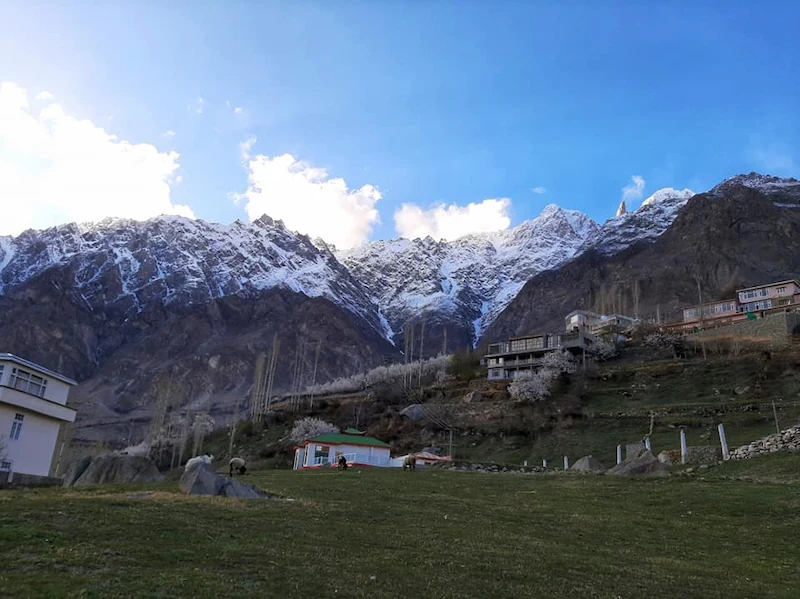
Why Visit: The oldest settlement in Hunza, with over 800 years of history. Blossoms here frame mud-brick mosques and historic watchtowers.
Photography Tip: The contrast of white-pink petals against earthy architecture is unique to Ganish.
Access: A short detour off the KKH before Karimabad.
9. Hopper Valley (Nagar)
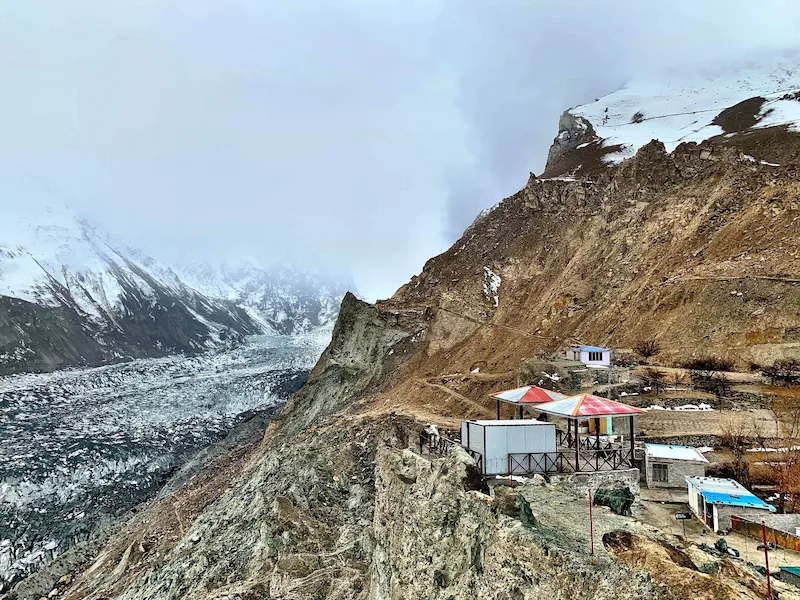
Why Visit: Across the Hunza River lies Hopper Valley, where cherry and apricot blossoms meet Hopper Glacier views.
Best For: Photographers seeking fewer crowds and a raw, village atmosphere.
Access: Cross the Hunza River bridge near Karimabad and drive 1 hour uphill.
10. Borith Lake
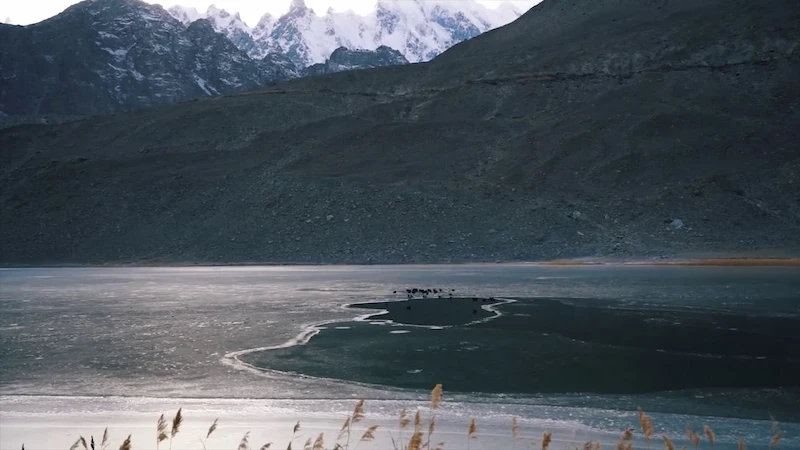
Why Visit: Calm waters mirror both the blossoms and the surrounding peaks. In spring, migratory birds like bar-headed geese visit the lake.
Photography Tip: Early morning reflections are crystal-clear before the wind picks up.
Access: 20 minutes uphill from Gulmit.
11. Hussaini Village
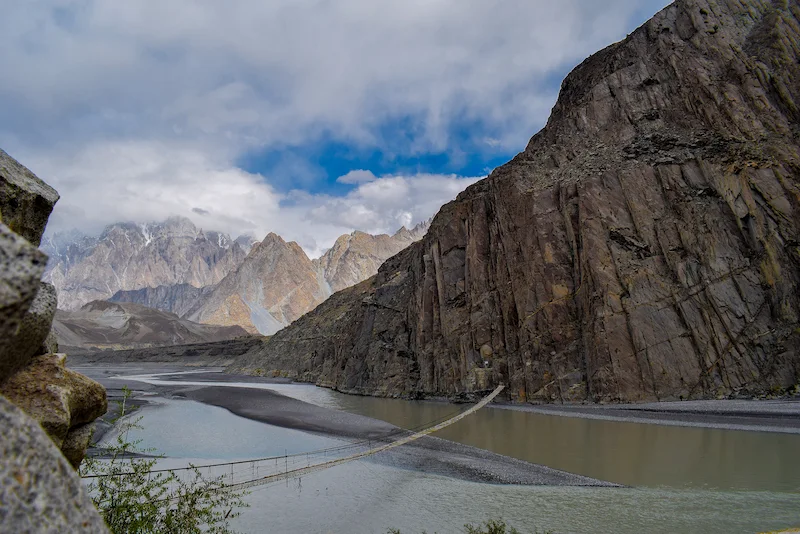
Why Visit: A rural gem with cherry blossoms framing the iconic Husseini Suspension Bridge.
Experience: Walk the bridge for thrilling views of both blossoms and the Hunza River below.
Access: 10 minutes north of Gulmit.
12. Shiskat
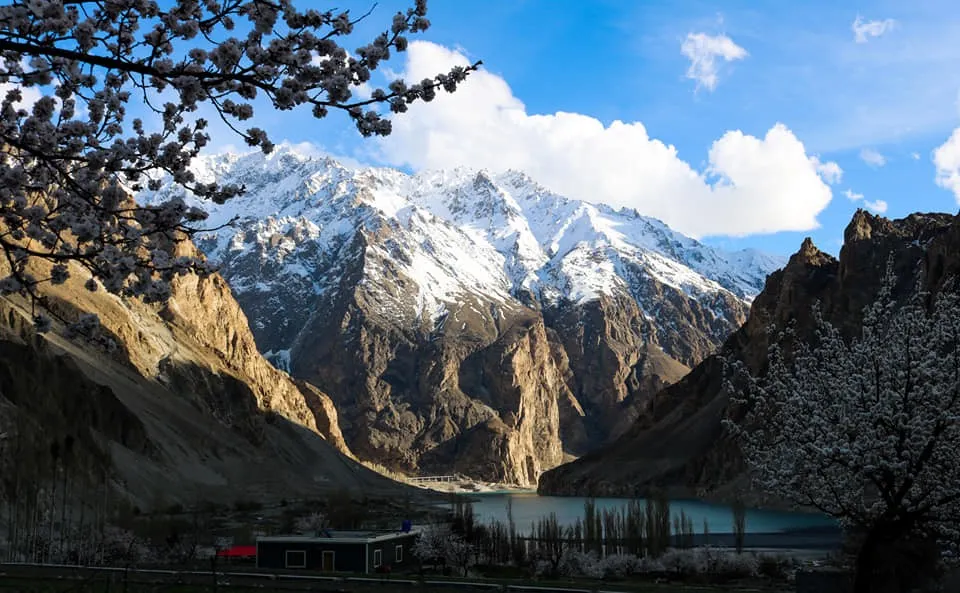
Why Visit: Nestled near Attabad Lake, Shiskat offers both water and blossom views in a peaceful setting.
Best For: Picnics under the trees with turquoise water glistening nearby.
Access: Just south of Gulmit on the KKH.
Hunza Spring Blossom Festival & Cultural Highlights
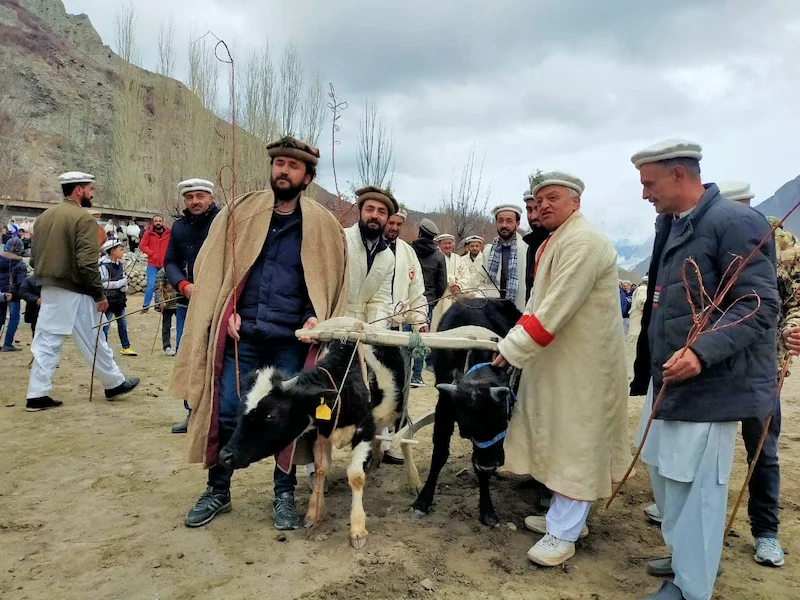
Cherry blossom season in Hunza is more than just a visual spectacle; it’s also the time for the Hunza Spring Blossom Festival, a vibrant celebration that blends nature, heritage, and community spirit.
This annual event transforms the valley into a stage for music, dance, and cultural exchange, drawing visitors from across Pakistan and beyond.
Navroz – The Spring Welcome
The festival coincides with Navroz on March 21, marking the Persian New Year and the arrival of spring. Locals gather in village squares and open fields for prayers, blessings, and music to welcome the season of renewal. The day begins with traditional attire, floral decorations, and heartfelt greetings, creating a warm and festive atmosphere.
Traditional Dances & Polo Matches
Cultural performances are at the heart of the celebration. Men perform Alghani and Thumak dances, moving in rhythmic circles to the beat of long drums and flutes.
Polo matches are organized between local teams, reviving the sport’s royal heritage. The combination of blossoms, music, and sport makes the whole valley feel alive.
A Feast for the Senses
Local food stalls serve springtime delicacies unique to Hunza. You’ll find walnut cake, chapshuro (meat-filled bread), fresh apricot juice, and sun-dried apricots, a taste of the valley’s organic produce.
Visitors often picnic under the blossoms, enjoying both the scenery and the flavors of Hunza’s traditional Foods.
Tree Planting & Community Spirit
A highlight of the festival is the tree planting ceremony, where elders and schoolchildren plant saplings to continue the valley’s agricultural tradition. This symbolic act reflects Hunza’s respect for nature and its deep-rooted belief in sustainability..
Why It Matters to Locals?
For the people of Hunza, the spring blossom season represents prosperity, renewal, and hope. It’s a reminder of the valley’s self-reliant farming heritage, the importance of unity, and the beauty of living in harmony with nature.
The festival isn’t just a tourist attraction, it’s a living tradition that has shaped Hunza’s identity for generations.
Photography Guide for Cherry Blossom in Hunza
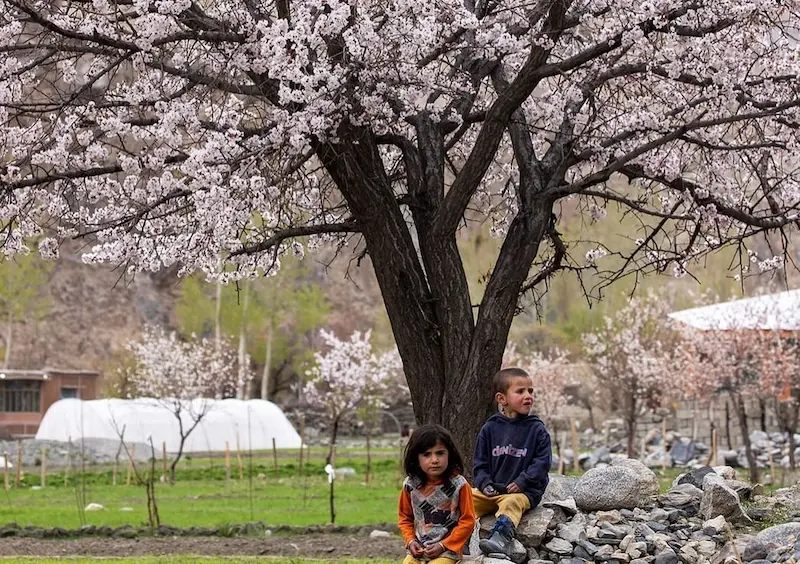
Capturing Hunza’s cherry blossoms is more than just pressing the shutter — it’s about timing, location, and composition. The valley offers endless frames where soft petals meet towering snow peaks, creating dreamlike shots that are hard to replicate anywhere else in the world.
Best Lighting – Morning Magic & Golden Hour Glow
Early morning light (7–9 AM) gives blossoms a soft, pastel look, with fewer shadows and minimal crowds. The golden hour before sunset bathes the valley in warm tones, perfect for capturing the pink hues against the white Karakoram peaks. Midday light can be harsh, so save that for shaded village shots or macro details.
Top Drone Photography Spots
Hunza’s topography makes it a paradise for aerial shots. From above, orchards look like a pink-and-white patchwork stitched into rugged mountainsides.
Baltit Fort offers elevated views over Karimabad’s blossoms, Duiker (Eagle’s Nest) reveals sweeping valley panoramas, and Hopper Valley in Nagar gives unique angles of glaciers surrounded by bloom.
Framing Blossoms with Iconic Peaks
The magic of Hunza’s cherry blossom photography lies in combining delicate petals with mighty mountains.
Look for blossom-lined alleys in Karimabad where Rakaposhi peeks between branches, or head to Passu Village for spiky Passu Cones framed by blooming orchards.
Where to Stay in Hunza for the Best Blossom Views?
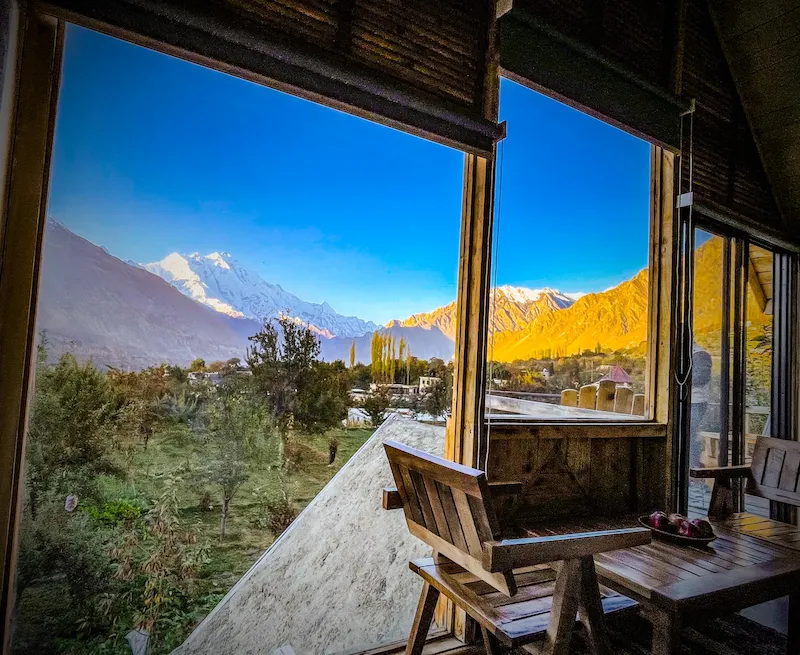
Hunza’s cherry blossom season is all about waking up to pink petals swaying outside your window with snow peaks in the distance. Choosing the right stay can make the experience unforgettable.
Top Blossom-View Stays:
- Hunza Serena Inn (Karimabad) – Elegant rooms with balconies overlooking blossom-filled orchards and the mighty Rakaposhi. Perfect for early-morning photography without leaving your room.
- Eagle’s Nest Hotel (Duiker) – Panoramic valley views from above, where entire villages appear wrapped in pink and white. Sunset here is legendary.
- Hard Rock Hunza (Karimabad) – Modern comfort meets unbeatable blossom scenery, especially from its rooftop café.
- Off-to-Resort (Altit) – A boutique eco-stay surrounded by blooming gardens, just steps from Altit Fort and the Royal Garden.
- Hunza Elites Hotel (Aliabad) – Spacious balconies facing terraced fields that glow with color in spring.
Insider Booking Tips:
- Book 3–4 months in advance for stays in late March — peak season fills up fast.
- Request “blossom view” or “Rakaposhi-facing” rooms when reserving.
- Duiker stays offer the widest panoramic views, while Karimabad puts you closer to cultural sites.
Hunza Spring Foods You Must Try
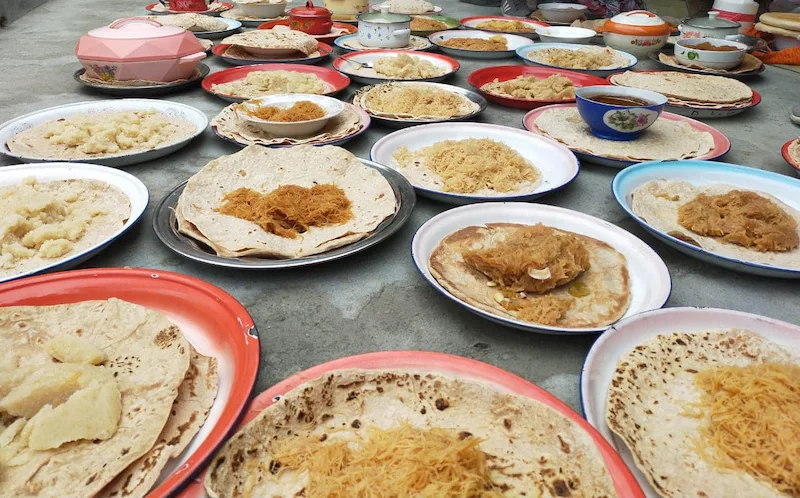
Spring in Hunza is not only a feast for the eyes but also for the taste buds. The season brings fresh, local ingredients and time-honored recipes that are best enjoyed with a view of blooming orchards.
Seasonal Delicacies:
- Apricot & Walnut Treats – From dried apricot snacks to walnut-stuffed pastries, these are the flavors of Hunza’s orchards.
- Chapshuro – A stuffed meat pie seasoned with local herbs, perfect after a day of blossom walks.
- Diram Phitti – A sweet, wholesome bread made from sprouted wheat flour, traditionally served with butter.
- Hunza Bread (Phitti) – Dense, hearty bread baked in clay ovens, often enjoyed with apricot oil.
Best Cafés & Restaurants with Blossom Views:
- Café de Hunza (Karimabad) – Famous walnut cake paired with coffee, best enjoyed on the terrace.
- Altit Café (Altit Fort) – Offers blossom-framed dining with views over the Hunza River.
- Hidden Paradise Café (Duiker) – Cozy spot for tea with sweeping blossom panoramas.
Travel Tips for Visiting Hunza During Blossom Season
Reserve hotels at least 2–3 months in advance; popular stays in Karimabad and Duiker sell out quickly. Here are some expert tips for a memorable journey:
- Dress in Layers: Spring days are mild (15–20°C) but mornings and nights can drop below 5°C. A light jacket is essential.
- Be Respectful: Many orchards are privately owned. Always ask permission before entering or photographing inside.
- Photography Prep: Carry extra SD cards & batteries — you’ll take more photos than you expect.
- Stay Flexible: Weather can shift quickly; keep an extra day in your itinerary in case of cloudy skies.
How to Reach Hunza for Spring Blossom?
Reaching Hunza Valley is an adventure in itself, offering travelers breathtaking views whether they fly over the mighty peaks or journey along the legendary Karakoram Highway, one of the highest paved roads in the world.
By Air:
- Islamabad → Gilgit via PIA (approx. 1-hour flight). From Gilgit, Hunza is a 2.5–3 hour drive along the Karakoram Highway.
- Note: Flights are weather-dependent, so keep a road backup plan.
By Road:
- Islamabad → Hunza via Karakoram Highway takes 18–20 hours, best done over 2 days.
- Route 1: Islamabad → Besham → Chilas → Hunza (open year-round).
- Route 2: Islamabad → Naran → Babusar Pass → Gilgit → Hunza (scenic but only open June–October).
Scenic Stopovers: Naran (lush valleys in summer), Besham (river views), Chilas (mountain panoramas).
Other Blossoms to See in Hunza
Cherry blossoms aren’t the only stars of Hunza’s spring, the valley bursts into a rainbow of fruit blossoms:
- Apricot Blossoms (white): Early to mid-March in Lower Hunza, late March in Upper Hunza.
- Almond Blossoms (light pink): Usually bloom slightly before cherries, adding soft blush tones to the landscape.
- Walnut Blossoms: Less showy, but unique in shape and texture; appear around the same time as cherries.
Tip: The last 10 days of March often feature multiple blossoms blooming together, creating the most colorful vistas.
Conclusion – Your Perfect Spring Escape
Cherry blossom season in Hunza is more than just a floral spectacle, it’s a celebration of nature, culture, and life in the heart of the Karakoram.
Imagine strolling through centuries-old villages draped in pink, sipping walnut tea on a balcony overlooking Rakaposhi, and joining locals in Navroz festivities.
Plan early, pack your camera, and let Hunza’s spring charm become your next unforgettable travel memory.
FAQs About Cherry Blossom in Hunza
1- When is the cherry blossom season in Hunza?
Cherry blossom season typically runs from mid-March to mid-April, with exact timing depending on altitude and microclimate. Lower Hunza blooms earlier, while Upper Hunza peaks later.
2- How long does the cherry blossom last?
Peak bloom at each altitude lasts only 2–3 weeks before petals begin to fall. Traveling up the valley can extend your viewing window to almost a month.
3- Where is the best place to see cherry blossoms in Hunza?
Karimabad, Duiker, Altit Fort, and Gulmit offer spectacular views with blossoms framed by snow-capped peaks. Each spot has unique angles for photography.
4- Is Hunza crowded during cherry blossom season?
It’s the valley’s second busiest season after autumn foliage. Weekdays see fewer tourists, while weekends and Navroz week draw larger crowds.
5- What is the Navroz festival in Hunza?
Celebrated on March 21, Navroz marks the Persian New Year with prayers, polo matches, traditional dances, and community feasts under the spring blooms.
6- Can I see cherry blossoms in Skardu?
Yes, Skardu’s cherry blossom season usually starts in late March and lasts into mid-April. The scenery is equally stunning but with fewer crowds.
7- Is March a good time to visit Hunza?
Yes, March offers cooler weather, fresh blooms, and a peaceful atmosphere before the busy summer tourist season begins.
8- What camera gear is best for cherry blossom photography?
A wide-angle lens captures sweeping landscapes, while a macro lens is perfect for close-up petals. Drones add dramatic aerial perspectives of the valley.
9- Are there any guided cherry blossom tours?
Yes, local tour operators run 3–5 day blossom tours covering top photography spots, cultural highlights, and local spring festivals.
10- Can I visit Hunza in cherry blossom season with family?
Absolutely, the mild weather, scenic views, and cultural activities make it a family-friendly destination in spring.


